Site menu:
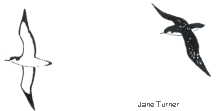
August 2009 Newsletter
Eleven Star Rarities.
Short-toed Lark in Wirral.
July Bird News.
Forthcoming Events.
Latest Newsletter.
This website has now been in existence for just over 11 years and over that time period there have been plenty of rarities to report. As I often look back to see what was around in previous years I thought it would be interesting to list 11 of the best rarities over the past 11 years which stand out from the crowd. These are ones seen in the Dee Estuary area as covered by this website. To narrow down the possibilities a bit I have only considered species which have appeared just once in those 11 years (since March 1998). Apart from the Cory's Shearwater they were all well watched birds so should bring back some happy memories to those who saw them. Here is my list in date order with a bit of background to put the records in perspective.
Woodchat Shrike
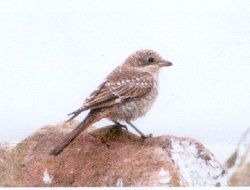 A juvenile was trapped and ringed at Hilbre on Aug 9th
1998 and remained until Aug 11th. It was found by John Gittins who also saw
the only other Woodchat Shrike found on Hilbre way back on May 10th 1958.
The only other possible record for the Dee Estuary area is one that was in
Flintshire sometime between 1958 and 1985 according to Dymond et al., but I
have been unable to ascertain the exact place or year.
A juvenile was trapped and ringed at Hilbre on Aug 9th
1998 and remained until Aug 11th. It was found by John Gittins who also saw
the only other Woodchat Shrike found on Hilbre way back on May 10th 1958.
The only other possible record for the Dee Estuary area is one that was in
Flintshire sometime between 1958 and 1985 according to Dymond et al., but I
have been unable to ascertain the exact place or year.
In this country Woodchat Shrikes are observed mainly during spring and
autumn migrations predominately along the south coast and also on the
Shetland Islands with typically a total number of records each year of
between five and ten. They breed mainly in southern Europe and north-west
Africa and winter south of the Sahara. Photo above © Steve
Young - www.birdsonfilm.com.
Cory's Shearwater
One was observed by Gareth
Stamp, then the assistant RSPB Warden on the Dee Estuary, off Gronant on Jun
21st 1999. I believe this is the only record for this species for Clwyd.
There have been four accepted records off north Wirral and Hilbre - in 1980,
1986, 1991 and 1992.
This large shearwater is rare in the Irish Sea but is regular in late
summer and autumn off southern Ireland (mainly Cape Clear) and Cornwall
where occasionally hundreds can be seen. They breed on islands in the
Mediterranean and mid-Atlantic and winter off South Africa. It is likely
that many of the birds seen from the British Isles are non-breeders.
We are somewhat overdue to see another one here!
Marsh Sandpiper
This well watched bird arrived
at the Inner Marsh Farm RSPB reserve on Jul 21st 2002 and remained until
Jul 29th. It is the only record for the Dee Estuary area.
These elegant waders are rare throughout this country with usually just two
or three records a year, mainly in East Anglia and the south-east coast.
The total number of records for Great Britain from 1950 up to the end of
2007 was 124. It breeds occasionally in Finland and the Baltic countries
but mainly Ukraine and eastwards across Asia, it winters in East Africa and
southern Asia.
White-throated Sparrow
It is amazing to think that one of the rarest birds ever recorded in this area spent three days in my front garden in Caldy!
|
Yes, on May 21st 2003 I saw a strange bird on my patio
which was identified the following day as a White-throated Sparrow, it
stayed until May 23rd. This is the only record of this species (or any
other American passerine) in our area. |
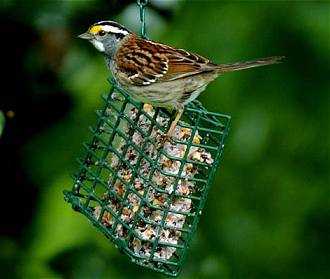 |
White Stork
A White Stork was observed by Graham
Broadbent flying over the Inner Marsh Farm RSPB Reserve on Apr 7th 2004, it
soon disappeared from view flying north-east. Luckily it returned on the
evening of the 8th where it was seen in a field adjacent to IMF (in
Flintshire) and then flew into the reserve proper where it eventually ended
up on No.2 pool (in Cheshire). It was present again the following morning
until 9.15am when it flew off in a north-east direction.
There have been three previous records in the Dee Estuary area - in 1976,
1982 and 1983. A report of three flying over Neston on Apr 23rd 2008 was
never confirmed but may well have been a genuine record.
Nationally the species is rare but records are fairly widespread with a
concentration in the south-east, mainly in spring. The species breeds on
the nearby continent.
Bonaparte's Gull
An adult Bonaparte's Gull in
summer plumage was found by Pete Wheeler on the evening of May 20th 2004 at
Inner Marsh Farm, it was observed for a couple of hours until dusk but was
not relocated the next day.
There are two other records for the Dee Estuary area with one present off
New Brighton between Mar 20th and Apr 20th 1991 and another at Inner Marsh
Farm for two weeks during Jun 1994.
Bonaparte's Gull breeds in northern North America and winters in the USA,
Mexico and West Indies. Nationally records are fairly widespread among
coastal counties with a total of 151 between 1950 and the end of 2007.
White-tailed Eagle
Colin Wells and Lynne
Greenstreet were out walking on Good Friday morning (Apr 6th 2007) by Decca
Pools, Burton Marsh. It was a quiet morning bird-wise and they were just about to
head home when Colin decided to have a quick sweep of the marshes hoping
for a Harrier species, instead he picked out a very large raptor heading towards
Heswall. It was relocated over Riverbank Road, Heswall, where it
spent some time soaring with two Common Buzzards - they must have been
somewhat startled to find themselves next to a White-tailed Eagle! It is
thought very likely that this bird was the same as that seen in
Nottinghamshire at the end of March 2007, then subsequently over North
Wales.
This was the first White-tailed Eagle to be seen in the Dee Estuary area
since one was shot at Leasowe sometime prior to 1874.
This species has been successfully re-introduced to Scotland although the
fact that this particular bird was not tagged means it is likely to be part
of the population from mainland Europe, but not all the Scottish birds are
tagged! Immatures do tend to wander and it is possible that this bird
wintered in France and was returning to the breeding area in
Germany, Denmark and eastern
Scandinavia via a westerly route.
Frustratingly this bird may well have been viewable from my house as it
flew inland from Heswall but
unfortunately I was out walking in Wales that day!
Black Kite
Steve Williams saw a Kite, initially
assumed to be Red, whilst driving along the M53 near Storeton on the
evening of Apr 29th 2007. After relocating it he and Frank Duff identified
it as a Black Kite. The bird was seen to go into a nearby wood to roost and
it was present the next morning giving many people the
opportunity of viewing it. It flew right overhead where I was standing!
There has been one previous record in the Dee Estuary area with one at
Gronant on Apr 24th 1994.
Records of Black Kites are increasing in this country with a recent
expansion of the species' range in continental Europe.
Radde's Warbler
Colin Jones found a Radde's
Warbler along Lingham Lane, Moreton, on the morning of Oct 16th 2007. It
was present for the rest of the day although sometimes hard to see among
the undergrowth. Unfortunately it disappeared during
the clear night which followed.
This is the first record for the Dee Estuary area and indeed the first
mainland record for the whole of the North-West region.
There were 273 Radde's Warbler records for this country between 1950 and
the end of 2006, mainly in east coast counties and the Scilly Isles, all in
the autumn. For a species which breeds in central Siberia and winters in
Indochina and Thailand this is a surprisingly large number but many must
undergo drift migration westwards after breeding. Photo below Neil McLaren
©.
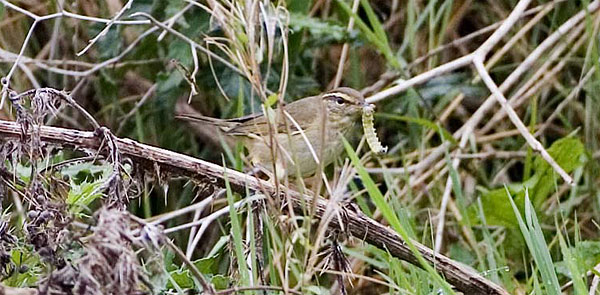
Whiskered Tern
A Whiskered Tern which was
spotted at the Conwy RSPB reserve on the morning of May 9th 2008 soon flew
off north-east, luckily it was relocated at Inner Marsh Farm the same
evening. Although it again soon flew off it reappeared the next morning and
stayed until the 19th apart from flying off SW each evening - probably to
roost at Shotton where the Common Terns breed.
The only other record for the Dee Estuary area was one at Shotton on Jul
5th 1976.
There were 133 records of this marsh tern across the country between 1950
and 2007. They breed in southern Europe but main concentration is from the
Black Sea and east to Kazakhstan, they winter in tropical Africa and East
Africa from Nile southwards.
Glossy Ibis
The Glossy Ibis which had spent
several months in the north-west, mainly at the Marshside RSPB reserve at
Southport, decided to make a visit to Inner Marsh Farm RSPB reserve on Jul
16th 2008, it remained the following day before heading north to Martin
Mere.
There have been two previous records of Glossy Ibis to the Dee Estuary
area. One was on the Welsh side of the estuary between Sep 16th and Oct 4th
1959 and one was on Burton Marsh Nov 24th and 25th 1996.
Nationally there were 92 records between 1950 and 2006, then a record
breaking number of at least 29 individuals in 2007! They breed in France
and Spain, also across to the Ukraine and further east.
Sources of Information:
1. Latest Sightings and Newsletters from
www.deeestuary.co.uk.
2. A. Conlin and S. Williams, Rare Birds in Cheshire & Wirral, CAW Birding,
2004.
3. Cheshire and Wirral Bird Reports - various.
4. Clwyd Bird Reports - various.
5. Birding North West - various.
6. British Birds - various.
7. Cramp & Simmons, Birds of the Western Palearctic, DVD edition (BWPi).
8. Dymond, Fraser and Gantlett, Rare Birds in Britain and Ireland, T & AD
Poyser, 1989.
Short-toed Lark in South Wirral
On 12th May 2009 Barry Barnacal found a Short-toed Lark land on private land on the Cheshire/Flintshire border. The track favoured by the bird was the direct access route for farm vehicles. As this was a particularly busy time of the year for the farmer (harvesting his vegetable crops) and there were a number of health and safety issues, a decision was taken not to release the news to the wider birding community. However, Barry did manage to arrange for several Cheshire, Wirral and Flintshire birders whom he knew well to see the bird during its stay (the bird stayed until 16th May 2009).
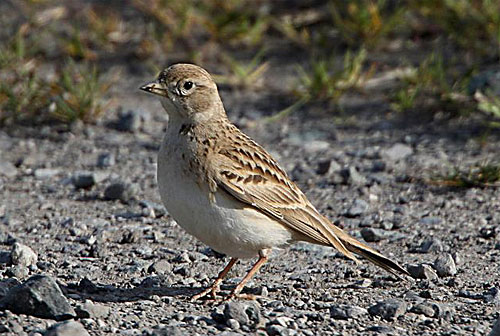
In an amazing co-incidence Barry also found the previous Wirral record of
Short-toed Lark near Leasowe Lighthouse on 5th and 6th May 1995 (in the same field as
this year's Stone Curlew - see BNW Vol 6:4). Fortunately, that bird was on
fields easily viewable from a public footpath and many North West birders saw that bird. There
have now been three records in Wirral - the first was near Meols Wastewater Treatment
Works between 13th and 18th October 1972, the second near Leasowe
Lighthouse in 1995 and this May's bird. Hopefully, the next time a good bird turns up in the area it
will be in a more accessible location....
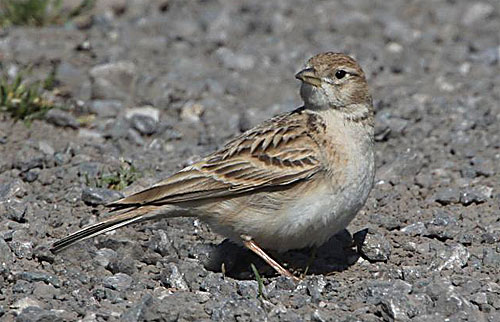
This article was first published in
Birding North West Volume 6 No 5 and
reproduced here with kind permission of the editors and Barry Barnacal.
Steve Williams and Allan Conlin.
July Bird News
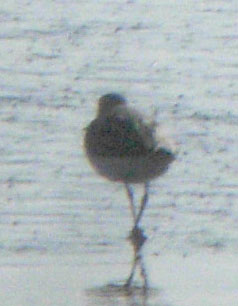 On the
afternoon of the 14th a Terek Sandpiper was seen briefly by Stephen Hinde on
Heswall shore as the tide came in. It was
relocated early the following morning when it was seen by a few birders as it
moved north as the tide went out when it again disappeared. A larger gathering
of birders gathered for the afternoon tide and were rewarded with further views,
although the bird was somewhat distant as you can tell by the photograph (left),
taken by Stephen Menzie! This is the first record for Wirral and second for the
Cheshire & Wirral recording area, this species normally spends the summer far to
the east of us and breeds across northern Russia to eastern Siberia.
On the
afternoon of the 14th a Terek Sandpiper was seen briefly by Stephen Hinde on
Heswall shore as the tide came in. It was
relocated early the following morning when it was seen by a few birders as it
moved north as the tide went out when it again disappeared. A larger gathering
of birders gathered for the afternoon tide and were rewarded with further views,
although the bird was somewhat distant as you can tell by the photograph (left),
taken by Stephen Menzie! This is the first record for Wirral and second for the
Cheshire & Wirral recording area, this species normally spends the summer far to
the east of us and breeds across northern Russia to eastern Siberia.
Heswall saw the normal large post-breeding build up of waders with 1,600 Curlew and 3,800 Redshank. Among the gulls up to five Mediterranean Gulls were counted and four were also at West Kirby with ones and twos along north Wirral. The West Kirby Marine Lake remained empty for most of the month and proved very attractive to the Sandwich Terns with a max of 741. They were very tolerant of all the work being carried out on the lake wall and it was great just to sit on the promenade and listen to the racket they were making! They must have had a good breeding season with plenty of young birds around.
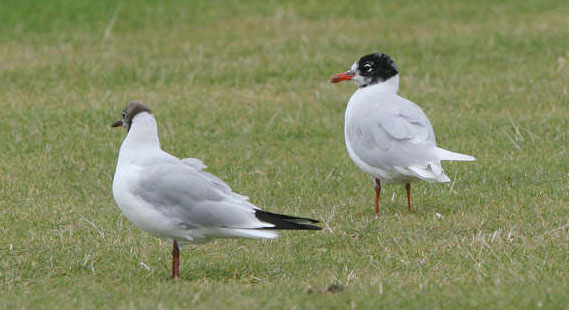
For most of the month sea-watching was poor but a fresh wind on the 7th produced 72 Manx Shearwater off Point of Ayr. The wind was light on the 15th but it was a good day at Gronant with 166 Common Scoter, 78 Gannets and 26 Manx Shearwaters, plus six Dolphins.
A remarkable 11 Common Sandpiper were at Gilroy Nature Park, West Kirby, on the 24th. Whimbrels trickled through the area for most of the month with 15 at Hilbre on the 31st the highest count. One or two Quails were heard calling at Parkgate and Inner Marsh Farm, three Hobbies was a good count at IMF on the 27th.
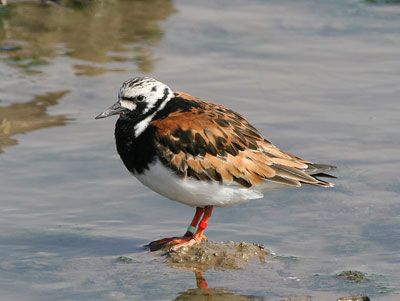
25th July, © Steve Seal. This one was ringed on Hilbre last winter.
Richard Smith.
What to expect in August
A month for terns with several hundred, probably thousands, of both Sandwich and Common Terns on the estuary and nearby Liverpool Bay using the area to feed up prior to their journey south for the winter. Hilbre at low tide is a great place to see them roosting on the sand bank next to Hilbre itself and also across the channel on West Hoyle Bank. The nesting season for the Little Terns at Gronant will come to an end in early August and they too disperse into the estuary. Arctic, Roseate and Black Terns may also be seen but these are comparatively rare.
Given some strong west winds seawatching can be superb this month. Storm Petrels are probably the bird most birders are after, they can be very difficult to see in the waves but most reliable place to get a good view is Hilbre, and by the end of the month we could also get Leach's Petrels. Also try the mouth of the River Mersey off New Brighton if the wind is at or near gale force. Arctic Skuas will be passing through and sometimes several can be seen together. Look out for the rarer Great and Pomarine Skuas. Manx Shearwaters will be flying in Liverpool Bay and there is also the possibility of something much rarer such as a Sooty Shearwater.
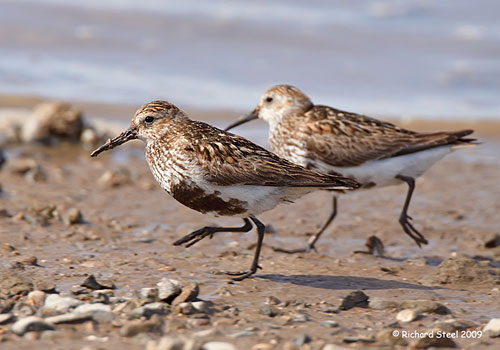
Wader numbers will be high throughout the estuary - something of a surprise to some people who think they are here only in winter. There will be huge numbers of Redshank particularly at Heswall. Inner Marsh Farm and Connah's Quay should have hundreds of migrating Black-tailed Godwits, last year we also had a few hundred at Parkgate, Gilroy Nature Park and Heswall. One of the birds I also look forward to seeing are Grey Plovers looking glorious in their summer plumage. Hoylake is a good spot for these along with Dunlin, Sanderling and Ringed Plover. By the end of the month we could also get Little Stints and Curlew Sandpipers - sometimes difficult to spot among all the Dunlin. Other rarer waders should include Greenshank and Common, Green and Wood Sandpipers - Parkgate, Inner Marsh Farm and Connah's Quay are the best sites for these.
Teal can build up to impressive numbers at Inner Marsh Farm in August, and out in the estuary Shelduck will return in their hundreds after moulting. Little Egrets will undoubtedly continue their increase in numbers - look for them flying to their roost at Burton in the evenings when well over two hundred should be present. Out on the marshes look for Marsh Harriers and maybe an early Hen Harrier or two.
A still overcast day is likely to result in gatherings of hundreds of Hirundines after insects, particularly flying ants, which are also likely to attract hundreds of Black-headed Gulls overhead.
Forthcoming Events
August Highest Spring Tides (Liverpool)
Also see
Tides page.
21st August, 12.43hrs (BST), 9.7m.
22nd August, 13.27hrs (BST), 9.8m.
Forthcoming Events
Organised by the
Wirral Ranger Service ,
Flintshire Countryside Service and/or the RSPB:
All these events and walks have bird interest, even those not advertised
specifically for birdwatching. No need to book for these events unless
specified - please check below.
Thursday 6th August, In Search of the Silent Hunter - 7.30pm start.
A free guided walk to look for the enigmatic barn owls that live in the
area around Parkgate. This event is held
in conjunction with the Wirral Barn Owl Trust. This event is free and
interested parties should meet at the Old
Baths car park, Parkgate at 7.30pm. Bring your binoculars, suitable
clothing and footwear. All are welcome but children must be accompanied by
adults.
RSPB Event.
Saturday 8th August, Spectacular Sandwich Terns at
West Kirby.
10am until 4pm - Pop along to West Kirby at any time during the day to find
out more about Britain's largest breeding tern. Staff and volunteers from
the RSPB and Wirral Council ranger will be on hand with binoculars and
telescopes to watch as these birds feed up their young before the long haul
flight to their wintering grounds in Africa.
Saturday 8th August, 11am start, Terns and Waders at
Point of Ayr.
August is a great month to see Terns and Waders on the Dee Estuary and
Liverpool Bay. We would expect to see hundreds of Sandwich Terns and good
numbers of Little and Common Terns hopefully with attendant juveniles. The
waders will still be in their breeding plumage, some looking very different
from their 'normal' winter plumage. We would certainly expect to see
Dunlin, Sanderling and Ringed Plover. Hopefully Grey Plovers, Bar-tailed
Godwits and Knot will also be present.
(HT 13.30, 8.7m). For further information
ring RSPB – 0151 3367681.
Meeting point:
Smugglers Inn car park.
Thursday 20th August, Marsh Walk and Birdwatch at
Heswall.
Join the Wirral Country Park Rangers at this premier birdwatching site on
the Internationally important Dee Estuary.
An area where mudflats meet marsh and thousands of wading birds and
wildfowl feed.
As the tide floods in they form into dense flocks as they prepare to roost.
This alerts birds of prey like Peregrines and Merlins to the chance of a
meal.
Come along with us to witness this wildlife spectacular.
9.30am Start, meet at Banks Road car park Lower Heswall.
For further enquiries Tel: 0151 648 4371/3884.
Thursday 20th August, Sunset Walk to
Hilbre.
Cross the sands to discover the islands wildlife and history. A 4 mile walk
of 4 hours, ideal for first time visitors. Please bring warm waterproof
clothing and a snack. Wellies are recommended.
There is a charge of £1.00 per person for this event.
Suitable for all the family to enjoy. All children under 8 must be
accompanied by an adult. Sorry no dogs.
Booking essential.
For further enquiries Tel: 0151 648 4371.
The Big Dee Festival
Saturday 22nd August – Sunday 30th August
A week of events celebrating the Dee Estuary, and its past, present and
future; including some bird related events. There is a high tide walk along
West Kirby Shore planned for 23rd August, details to be announced shortly.
Saturday 22nd August, "Mud Matters".
Shore Walk and Birdwatch, join the Rangers as they follow the rising tide
along Thurstaston shore.
As the channels and the gullies of the mudflats fill up, many a Redshank,
Knot, Curlew and Dunlin will be forced into the open and Pintail will start
to drift toward the Heswall marshes.
We will then cross Heswall Fields and join the Wirral way looking for
hedgerow and farmland birds as we head back to the Visitor Centre. Bring
binoculars and waterproofs.
11.00am Start, meet at Wirral Country Park Visitor Centre at Thurstaston.
For further enquiries Tel: 0151 648 4371/3884.
Saturday 22nd August, High Tide Big Bird Watch at
Flint Castle, 11am Start.
Join all of the areas wildlife and conservation groups for a joint bird
watch. High tide is due at 13.27 at a height of 9.8m. Flint Castle
provides excellent views over the estuary and we should see hundreds of
birds moving to roost away from the in-coming tide. This is part of the
opening day of this years Big Dee Festival which celebrates the
estuary and its heritage - so bring along the whole family for a fun-packed
day.
Sunday 23rd August, Terns and Waders at
West Kirby, 12 Noon Start.
Join the Voluntary Wardens for a guided walk along West Kirby shore. At
this time of year the shore should be full of Sandwich and Common Terns,
Oystercatchers and Curlew plus a good selection of smaller waders - we may
even be lucky and spot a Curlew Sandpiper or Little Stint. These birds will
be driven in towards the shore as the tide comes in making for a
spectacular sight. High tide is 1.39pm, height 9.6m. Bring binoculars if
you have them, telescopes will be available for you to look through. Meet
at the shore end of Dee Lane, West Kirby, where there is a notice board
next to the sailing school. For
further enquiries
(richard
at deeestuary dot co dot uk).
Saturday 29th August, Night Walk with Barn Owls.
Enjoy a talk by Steve Harris of The Wirral and Cheshire Barn Owl Trust and
afterwards go for a Ranger-led walk and see the Barn Owls hunting –
hopefully! Sorry no dogs. Booking essential.
Time:
8.00pm – 11pm, for further enquiries
Tel: 0151 648 4371.
|
 |
The blank (UK) Birding Webring is a collection of quality birding web sites that are based in the United Kingdom. Visit the webring homepage for more information, or A complete list of all the sites in the webring is available by clicking here. previous site in ring : random site in ring : next site in ring |